Lichtenstein radar



Lichtenstein radar was a German airborne radar in use during World War II. It was available in at least four major revisions, the FuG (Funk-Gerät) 202 Lichtenstein B/C, FuG 212 Lichtenstein C-1, FuG 220 Lichtenstein SN-2 and FuG 228 Lichtenstein SN-3.
FuG 202 Lichtenstein B/C
Early FuG 202 Lichtenstein B/C units were not deployed until 1942. They operated at a maximum RF output power of 1.5 kW, on the 75 cm wavelength (490 MHz, or low UHF band), requiring complex Matratze (mattress) antennas, consisting of a total of thirty-two dipole elements, mounted in four groups of eight, each at the forward end of one of four forward-projecting masts.
FuG 212 Lichtenstein C-1
During 1943 the Lichtenstein B/C was improved as the FuG 212 Lichtenstein C-1, with longer range and wider angle of view, still operating at UHF Frequencies between 420 and 480 MHz and using the complex Matratze aerial set. By this point in the war, the British had become experts on jamming German radars. A B/C-equipped Ju 88 R-1 night fighter, Werknummer 360 043, defected in April 1943 and landed in Scotland, presenting a working example of the German radar for the first time, with the aircraft itself, still in existence as of the 21st century, becoming a museum exhibit in the UK. The subsequent refinement of 'Window' (known as Düppel by the Luftwaffe, from the German town it was first found near) rendered Lichtenstein B/C almost useless for several crucial weeks.
FuG 220 Lichtenstein SN-2
By late 1943, the Luftwaffe was starting to deploy the greatly improved FuG 220 Lichtenstein SN-2, operating on a longer-wavelength of 90 MHz (lower end of the US VHF FM broadcast band) frequency which was far less affected by electronic jamming, but this required the much larger Hirschgeweih (stag's antlers) antennas, with only eight dipole elements, looking like a much-enlarged version of what occupied the forward end of each one of the earlier quadruple Matratze masts. This aerial setup also produced tremendous drag and slowed the operating aircraft by up to 50 km/h (30 mph). The first SN-2 set had a problem with a huge minimum range of 500 meters, initially requiring the retention of a supplementary B/C or C-1 set with its full set of four Matratze masts, but the alarming drag that full sets of both types of antennas caused, from both radars being installed, later changed the requirement to only a "one-quarter" subset of the earlier Matratze array at the end of a single mast, centrally mounted on the nose of the aircraft. Improvements in spring 1944 led to newer SN-2 versions with lower minimum range, which allowed the older UHF radar system to be removed entirely. In July 1944, the newest version of the SN-2 radar fell into Allied hands when a fully equipped Ju 88 G-1, of 7 Staffel/NJG 2, flew the wrong way on a landing beacon and landed in England by accident, with the crew not realising the mistake until it was too late to destroy the radar or IFF gear. This led to successful jamming of several frequency bands of the FuG 220 (I to III, 72, 81 and 90 MHz) but several other bands were still operational. After the Allied jammings the FuG 220 antenna setup was optimized for the still operational bands, the 90-degree vertical dipole setup was changed to a 45-degree diagonal setup.
Late-war developments
Late in 1944, the Morgenstern (Morningstar) antenna, consisting of three sets of two 90° crossed dipole elements per set, with each set of elements of progressively longer length from fore to aft, on a central, forward projecting mast, was developed. This was small enough to fit into the nose of a Ju 88, and was covered with a wooden cone. Further development led to the FuG 228 Lichtenstein SN-3 radar set but this saw little to no service.
A 9 cm wavelength system known as FuG 240 Berlin was developed, based on captured examples of the Allies' cavity magnetron technology but saw little to no operational use.
Allied countermeasures
The Allies were able to jam and track the early FuG 202 and 212 sets by Summer 1943. During several months in this period they rendered these sets almost useless by blinding them with 'Window', today known as Chaff. Fully jamming the SN-2 took longer but was probably accomplished by the Allies in late 1944 or early 1945. Much more dangerous were Mosquito intruders equipped with a device called Serrate to allow them to track German night fighters by emissions from their Lichtenstein B/C, C-1 or SN-2 sets.
An aerial manouvre known as the 'corkscrew' was developed to remove an attacked heavy bomber from within the 60-degree cone of coverage of an attacking night fighter's Lichtenstein radar. The technique was developed using the same early model UHF-band Lichtenstein-equipped, Ju 88R-1 night fighter that had landed at RAF Dyce in April 1943 by its defecting crew. It was also later flown in tests by the RAF's enemy aircraft evaluation unit, No. 1426 Flight, known colloquially as the 'Rafwaffe'.
